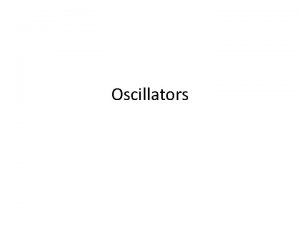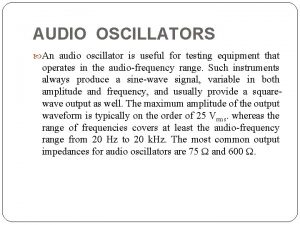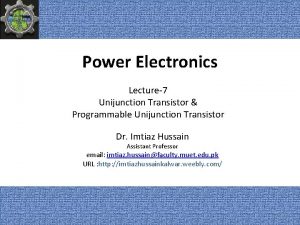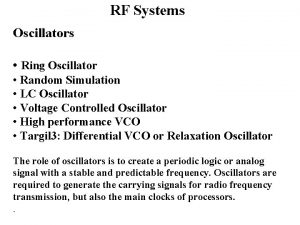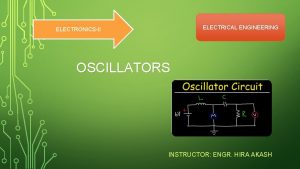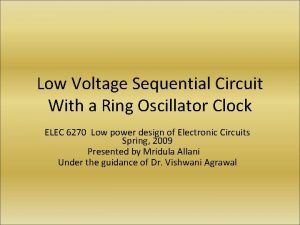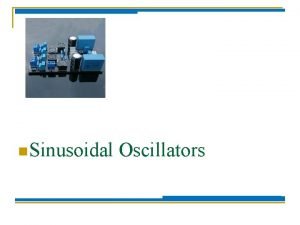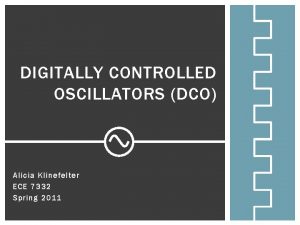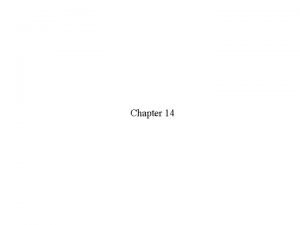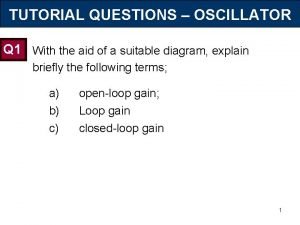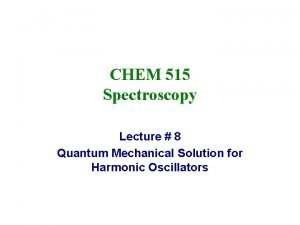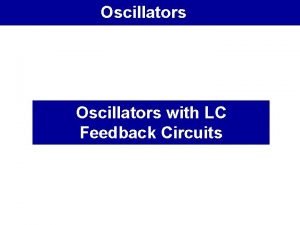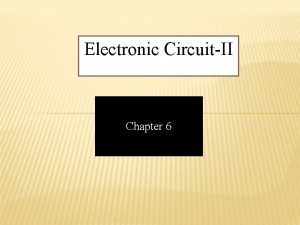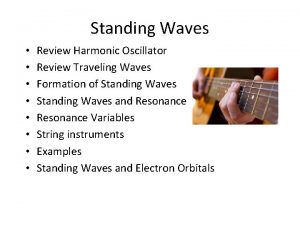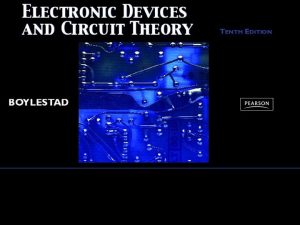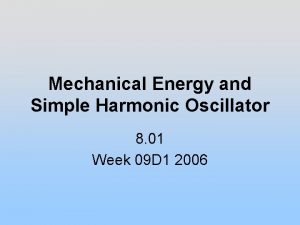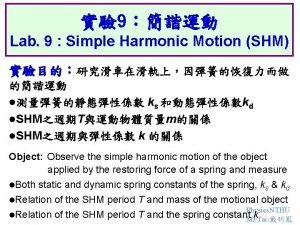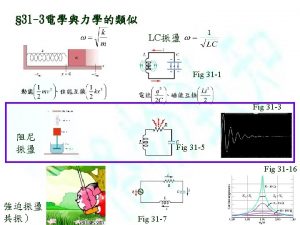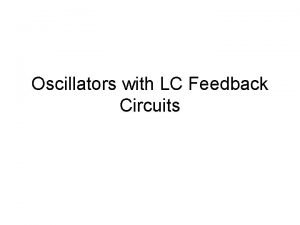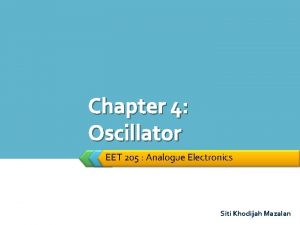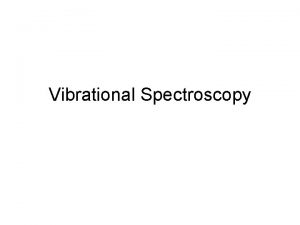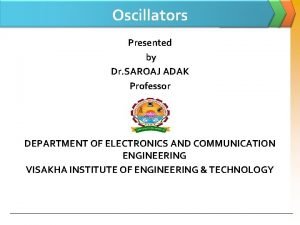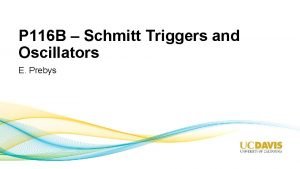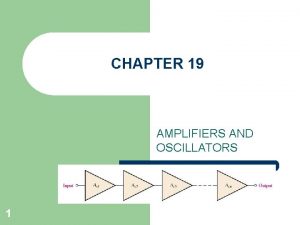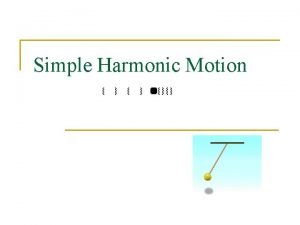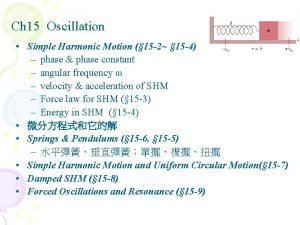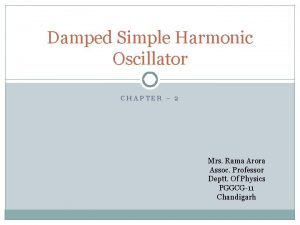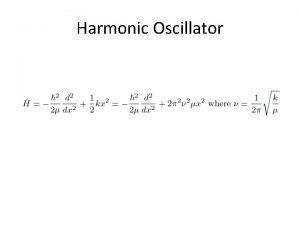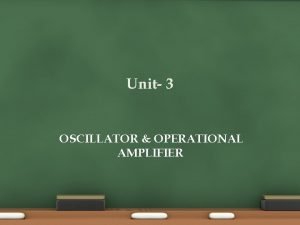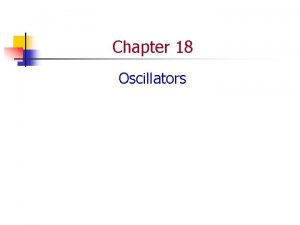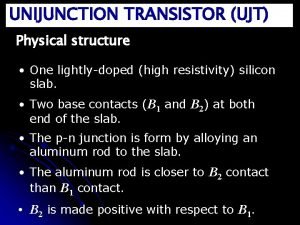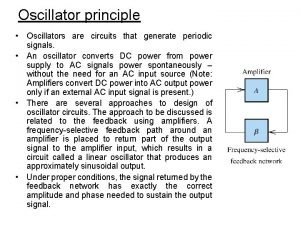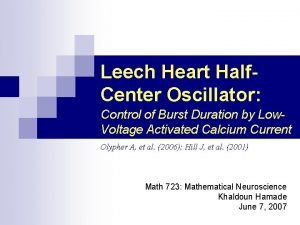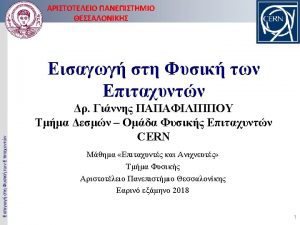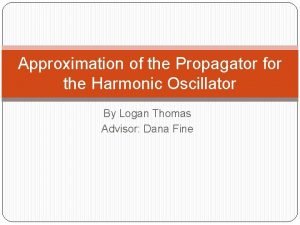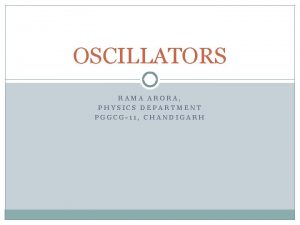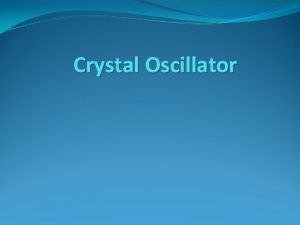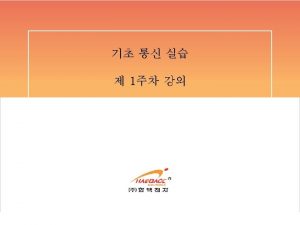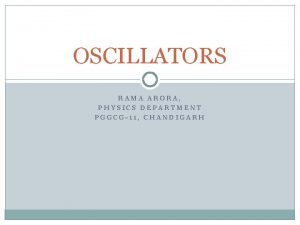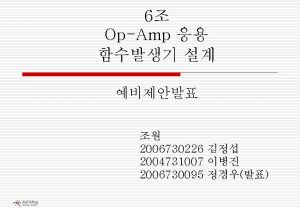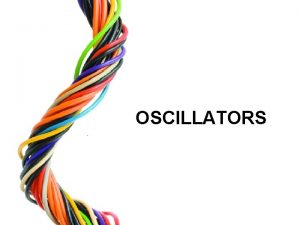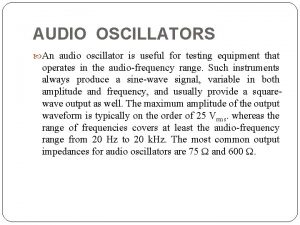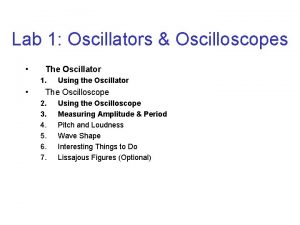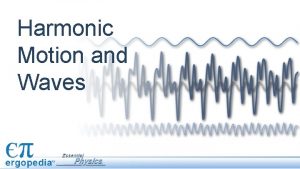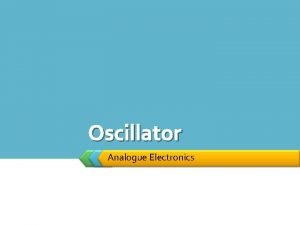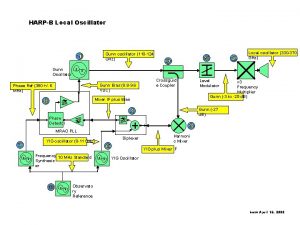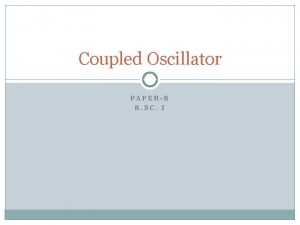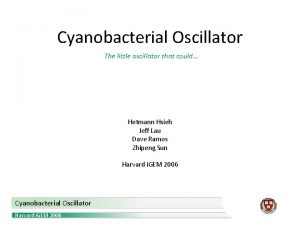Oscillators Need of an Oscillator An oscillator circuit

















































- Slides: 49

Oscillators

Need of an Oscillator • An oscillator circuit is capable of producing ac voltage of desired frequency and waveshape. • To test performance of electronic circuits, it is called signal generator. • It can produce square, pulse, triangular, or sawtooth waveshape. • High frequency oscillator are used in broadcasting. • Microwave oven uses an oscillator. • Used for induction heating and dielectric heating.

Types of Oscillators • • Sinusoidal or non-sinusoidal. An oscillator generating square wave or a pulse train is called multivibrator : 1. Bistable multivibrator (Flip-Flop Circuit). 2. Monostable multivibrator. 3. Astable multivibrator (Free-running). • Depending upon type of feedback, we have 1. Tuned Circuit (LC) oscillators. 2. RC oscillators, and 3. Crystal oscillators.

Using Positive Feedback • The gain with positive feedback is given as • By making 1 – Aβ = 0, or Aβ = 1, we get gain as infinity. • This condition (Aβ = 1) is known as Barkhausen Criterion of oscillations. • It means you get output without any input !

How is it Possible ? Connecting point x to y, feedback voltage drives the amplifier.

• What happens to the output ? • There are three possibilities.

(1) If Aβ < 1, we get decaying of damped oscillations.

(2) If Aβ > 1, we get growing oscillations.

(3) If Aβ = 1, we get sustained oscillations. In this case, the circuit supplies its own input signal.

Wherefrom comes the starting voltage ? • Each resistor is a noise generator. • The feedback network is a resonant circuit giving maximum feedback voltage at frequency f 0, providing phase shift of 0° only at this frequency. • The initial loop gain Aβ > 1. • The oscillations build up only at this frequency. • After the desired output is reached, Aβ reduces to unity.

Tank Circuit • LC parallel circuit is called tank circuit. • Once excited, it oscillates at


The energy keeps oscillating between electric potential energy and magnetic filed energy.

Damped oscillations are produced.

Tuned Collector Oscillator

Same circuit from ac point of view.

Tuned-Drain Oscillator

Building of oscillations using gate-leak biasing

How to take Output ?


Hartley Oscillator • Note that in the collector-tuned circuit, two inductor coils are used. • One end of these coils is grounded. • If we make the tickler coil an integral part of the circuit, we get Hartley Oscillator.

Hartley Oscillator

• When the tank circuit resonates, the circulating current flows through L 1 in series with L 2. Hence the equivalent inductance is The feedback factor is

Colpitts Oscillator • An excellent circuit. • Widely used in commercial signal generators. • Uses two capacitors instead of the inductive voltage divider.

Colpitts Oscillator

Its AC Equivalent


Solution :


RC Oscillators • Two types : 1. RC Phase shift Oscillator. 2. Wein Bridge Oscillator.

RC Phase shift Oscillator (Using phase-lead circuits)

RC Phase shift Oscillator (Using phase-lag circuits)

• A phase-lead or phases-lag circuit can provide phase shift between 0° and 90°. • For total phase shift 180°, we use three identical sections each giving a phase shift of 60°. & • It means in the beginning the gain of the FET amplifier must be greater than 29. • Not very popular, as the frequency cannot be adjusted over large range.

Wien Bridge Oscillator

• The two arms on the left of the bridge make leadlag circuit. • The two arms on the right, are 2 Rt and Rt, making a potential divider. • It has both positive and negative feedback paths. • Initially, when switched on, there is more positive feedback than negative feedback. • Oscillations build up. • Negative feedback increases, making Aβ = 1.

• The reason why the loop gain reduces to unity : 1. Initially tungsten lamp has low resistance; giving low negative feedback. 2. Thus, loop gain Aβ is greater than unity. 3. As oscillations are built up, the tungsten lamp heats up increasing its resistance. 4. Negative feedback increase to make Aβ = 1. • With sustained oscillations, the resistance of the lamp increases to exactly Rt , so that the gain becomes :

• At resonance, the voltage ratio or feedback factor of the lead-lag circuit is 1/3. • Therefore, loop gain becomes unity. • The oscillation frequency is the same as that of the lead-lag circuit,


Solution :

Crystal Oscillator • Used when accuracy and stability of fo is utmost important. • Where do you need such high stability of frequency of oscillations ? • Instead of an inductor, it uses a crystal of quartz, tourmaline, or Rochelle salt. • Piezoelectric effect. • The crystal is suitably cut and then mounted between two metallic plates. • The fundamental frequency is given as

Cm (mounting capacitance) = 3. 5 p. F; Cs = 0. 0235 p. F; L = 137 H; R = 15 kΩ

• • • Crystals have incredibly high Q. For the given values, Q = 5500. Q as high as 100 000 can be possible. An LC circuit has Q not greater than 100. The extremely high value of Q makes fo highly stable.


Series and Parallel Resonance • First, resonance occurs at fs for the series combination of L and Cs. • Above fs the series branch LCs. R has inductive reactance. • It then resonates at fp , with Cm. • For this parallel resonance, equivalent series capacitance is Cp.


• Normally, Cs is much smaller than Cm. • Therefore, Cp is slightly less than Cs. • Hence, the frequency fp is slightly greater than f s. • The crystal is inductive only between the frequencies fs and fp. • The frequency of oscillation must lie between these frequencies. • Hence the stability.

The fo is between 411 k. Hz and 412 k. Hz.

Crystal Oscillator Circuit.

Review Need of an Oscillator. Types of Oscillators. Using Positive Feedback. Barkhausen Criterion of Oscillations. • Starting Voltage. • Tank Circuit. • Hartley Oscillator. • Tuned Collector Oscillator. • Series and Parallel Resonance • • • Tuned-Drain Oscillator. • Colpitts Oscillator. • RC Phase Shift Oscillator. • Wien Bridge Oscillator. • Crystal Oscillator.
 Need of oscillator
Need of oscillator Audio frequency oscillator circuit
Audio frequency oscillator circuit Put transistor
Put transistor Ring oscillator
Ring oscillator Classification of oscillators
Classification of oscillators Low g oscillators 50low
Low g oscillators 50low Sinusoidal oscillators are
Sinusoidal oscillators are Digitally controlled oscillators
Digitally controlled oscillators The figure shows four oscillators at t=0
The figure shows four oscillators at t=0 Voltage in series and parallel
Voltage in series and parallel Phet circuit construction kit
Phet circuit construction kit Circulatory system labeled
Circulatory system labeled Series vs parallel
Series vs parallel Advantages of parallel circuits over series circuits
Advantages of parallel circuits over series circuits Compute the equivalent resistance of the network
Compute the equivalent resistance of the network Complete circuit and incomplete circuit
Complete circuit and incomplete circuit Type of circuits
Type of circuits Similarities of parallel and series circuits
Similarities of parallel and series circuits Phase shift oscillator
Phase shift oscillator Morse potential
Morse potential Colpitts oscillator frequency formula
Colpitts oscillator frequency formula Oscillator definition
Oscillator definition Malha
Malha Simple harmonic oscillator
Simple harmonic oscillator In a voltage shunt feedback circuit,
In a voltage shunt feedback circuit, Binary counter minecraft
Binary counter minecraft Mechanical energy
Mechanical energy Simple harmonic motion formulas
Simple harmonic motion formulas Simple harmonic oscillator
Simple harmonic oscillator Lc oscillator
Lc oscillator Lc feedback oscillator
Lc feedback oscillator Oscillator analog electronics
Oscillator analog electronics Migratory aptitude is greater for
Migratory aptitude is greater for Barkhausen criteria of oscillator
Barkhausen criteria of oscillator Relaxation oscillator schmitt trigger
Relaxation oscillator schmitt trigger An oscillator converts …………….. *
An oscillator converts …………….. * Nn linear
Nn linear Simple harmonic oscillator amplitude
Simple harmonic oscillator amplitude Relaxation time of damped harmonic oscillator
Relaxation time of damped harmonic oscillator Selection rule for harmonic oscillator
Selection rule for harmonic oscillator L c oscillator
L c oscillator Op amp oscillator
Op amp oscillator Mti radar vs pulse doppler radar
Mti radar vs pulse doppler radar Barkhausen criteria of oscillator
Barkhausen criteria of oscillator Ujt oscillator
Ujt oscillator An oscillator converts ……………..
An oscillator converts …………….. Half center oscillator
Half center oscillator Harmonic oscillator spring
Harmonic oscillator spring Harmonic oscillator propagator
Harmonic oscillator propagator Series fed hartley oscillator
Series fed hartley oscillator
